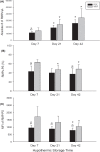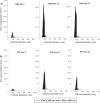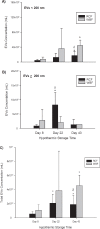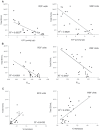Characteristics of Extracellular Vesicles in Red Blood Concentrates Change with Storage Time and Blood Manufacturing Method
- PMID: 29928174
- PMCID: PMC6006624
- DOI: 10.1159/000486137
Characteristics of Extracellular Vesicles in Red Blood Concentrates Change with Storage Time and Blood Manufacturing Method
Abstract
Background: Extracellular vesicles (EVs) in blood products are potential effectors of inflammation and coagulation after transfusion. The aim of this study was to assess the impact of different blood manufacturing methods and duration of hypothermic storage on the EV subpopulations in relation to other in vitro quality parameters of red blood cell concentrate (RCC) products.
Methods: RCCs were produced using whole blood filtration (WBF) or red cell filtration (RCF) (n = 12/method), refrigerated for 43 days, and evaluated for EV size profile and concentration, red cell deformability, ATP and 2,3-DPG, hemolysis, and hematological indices.
Results: The total number of EVs increased significantly with storage in both methods, and WBF-RCCs contained the higher numbers of EVs compared to RCF-RCCs. The concentration of small EVs was greater in WBF-RCCs versus RCF-RCCs, with difference between the two methods observed on day 43 of storage (p = 0.001). Throughout storage, significant decreases were identified in ATP, 2,3-DPG, and EImax, while an increase in hemolysis was observed in both RCC products.
Conclusion: The dynamic shift in the size and concentration of the EV subpopulations is dependent on the blood manufacturing method and length of storage. Better understanding of the potential clinical implications of these heterogeneous populations of EVs are needed.
Keywords: Blood processing; In vitro quality; Microparticles; Microvesicles; Red blood cells; Red cell filtered; Storage lesion; Whole blood filtered.
Figures




Similar articles
-
Buffy coat (top/bottom)- and whole-blood filtration (top/top)-produced red cell concentrates differ in size of extracellular vesicles.Vox Sang. 2015 Oct;109(3):214-20. doi: 10.1111/vox.12272. Epub 2015 Apr 20. Vox Sang. 2015. PMID: 25900231
-
Blood manufacturing methods affect red blood cell product characteristics and immunomodulatory activity.Blood Adv. 2018 Sep 25;2(18):2296-2306. doi: 10.1182/bloodadvances.2018021931. Blood Adv. 2018. PMID: 30217795 Free PMC article.
-
Screening of red blood cells for extracellular vesicle content as a product quality indicator.Transfusion. 2018 Sep;58(9):2217-2226. doi: 10.1111/trf.14782. Epub 2018 Aug 31. Transfusion. 2018. PMID: 30168148
-
Extracellular vesicle characteristics in stored red blood cell concentrates are influenced by the method of detection.Transfus Apher Sci. 2017 Apr;56(2):254-260. doi: 10.1016/j.transci.2017.03.007. Epub 2017 Mar 9. Transfus Apher Sci. 2017. PMID: 28363591 Review.
-
Extracellular vesicles in transfusion-related immunomodulation and the role of blood component manufacturing.Transfus Apher Sci. 2016 Dec;55(3):281-291. doi: 10.1016/j.transci.2016.10.018. Epub 2016 Oct 28. Transfus Apher Sci. 2016. PMID: 27865649 Review.
Cited by
-
Extracellular vesicles: new players in regulating vascular barrier function.Am J Physiol Heart Circ Physiol. 2020 Dec 1;319(6):H1181-H1196. doi: 10.1152/ajpheart.00579.2020. Epub 2020 Oct 9. Am J Physiol Heart Circ Physiol. 2020. PMID: 33035434 Free PMC article.
-
Mechanical stimuli such as shear stress and piezo1 stimulation generate red blood cell extracellular vesicles.Front Physiol. 2023 Aug 30;14:1246910. doi: 10.3389/fphys.2023.1246910. eCollection 2023. Front Physiol. 2023. PMID: 37719461 Free PMC article.
-
Circulating Platelet-Derived Extracellular Vesicles Are a Hallmark of Sars-Cov-2 Infection.Cells. 2021 Jan 7;10(1):85. doi: 10.3390/cells10010085. Cells. 2021. PMID: 33430260 Free PMC article.
-
Red Blood Cells: Tethering, Vesiculation, and Disease in Micro-Vascular Flow.Diagnostics (Basel). 2021 May 27;11(6):971. doi: 10.3390/diagnostics11060971. Diagnostics (Basel). 2021. PMID: 34072241 Free PMC article.
-
Red Blood Cell Extracellular Vesicle-Based Drug Delivery: Challenges and Opportunities.Front Med (Lausanne). 2021 Dec 24;8:761362. doi: 10.3389/fmed.2021.761362. eCollection 2021. Front Med (Lausanne). 2021. PMID: 35004730 Free PMC article. Review.
References
-
- Tzounakas VL, Georgatzakou HT, Kriebardis AG, Voulgaridou AI, Stamoulis KE, Foudoulaki-Paparizos LE, Antonelou MH, Papassideri IS. Donor variation effect on red blood cell storage lesion: a multivariable, yet consistent, story. Transfusion. 2016;56:1274–1286. - PubMed
-
- Jordan A, Chen D, Yi QL, Kanias T, Gladwin MT, Acker JP. Assessing the influence of component processing and donor characteristics on quality of red cell concentrates using quality control data. Vox Sang. 2016;111:8–15. - PubMed
-
- Greenwalt TJ, Bryan DJ, Dumaswala UJ. Erythrocyte membrane vesiculation and changes in membrane composition during storage in citrate-phosphate-dextrose-adenine-1. Vox Sang. 1984;47:261–270. - PubMed
-
- Dumaswala UJ, Dumaswala RU, Levin DS, Greenwalt TJ. Improved red blood cell preservation correlates with decreased loss of bands 3, 4.1, acetylcholinestrase, and lipids in microvesicles. Blood. 1996;87:1612–1616. - PubMed
LinkOut - more resources
Full Text Sources
Other Literature Sources

